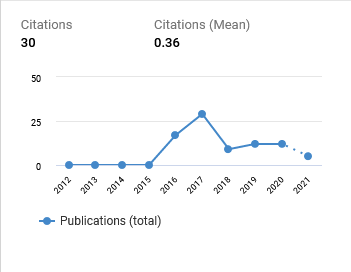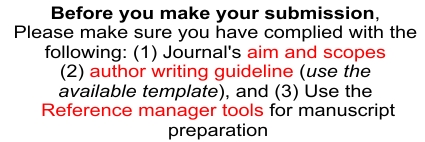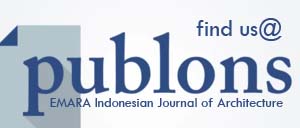Active Materiality as The Basis of Architectural Design in Dealing with Pollution
DOI:
https://doi.org/10.29080/eija.v8i1.1589Keywords:
materiality, living material, material growth, active-passive, pollutionAbstract
This paper describes the architectural design process based on an understanding of living materials’ properties and their growth process in response to pollution. The development of the design method was based on the existence of living materials and their potential to be the active unit of architecture. Living materials could actively grow and adapt through their reactions to external factors, in this case, pollution, allowing the material to be in a passive phase temporarily due to the forces. This paper focuses on the development of design methods based on the understanding of algae, fungi, and lichen as the living materials that will detect and detoxify air and soil pollution around Daan Mogot, West Jakarta. By conducting research through design, this paper then proposes architectural design by injecting the active-passive growth process of living materials (algae, fungi, and lichen) into the context using split and absorb mechanisms. In response to pollution, the active and passive schemes of living materials become the foundation of architectural design. This paper then proposes the term "active materiality," considering the existence and capability of the living materials as the active unit. The development of an architectural design method in this study demonstrates the possibility of design ideas to enhance dialogue between humans, other living things, and the environment and to develop programming to respond to environmental issues.
Downloads
References
Akhtar, N., & Mannan, M. A. (2020). Mycoremediation: Expunging environmental pollutants. Biotechnology Reports, 26, e00452. https://doi.org/10.1016/j.btre.2020.e00452
Ballantyne, A. (2016). The unit of survival. Architectural Research Quarterly, 20(1), 39–44. https://doi.org/10.1017/S1359135516000129
Beesley, P. (2016). Can architecture embody living systems? Emerging ‘living’ technologies and synthetic biology. Architectural Research Quarterly, 20(2), 92–94. https://doi.org/10.1017/S1359135516000439
Collet, C. (2021). Designing our future bio-materiality. AI & Society, 36(4), 1331–1342. https://doi.org/10.1007/s00146-020-01013-y
Dewsbury, J. (2012). Affective Habit Ecologies: Material dispositions and immanent inhabitations. Performance Research, 17(4), 74–82. https://doi.org/10.1080/13528165.2012.712263
Gabrys, J. (2018). Sensing Lichens: From Ecological Microcosms to Environmental Subjects. Third Text, 32(2–3), 350–367. https://doi.org/10.1080/09528822.2018.1483884
Gibson, J. J. (1986). The Ecological Approach to Visual Perception. Psychology Press.
Ingold, T. (2007). Materials against materiality. Archaeological Dialogues, 14(1), 1–16. https://doi.org/10.1017/S1380203807002127
Loschke, S. K., & Ludwig, F. (2016). In Materiality and architecture. https://www.taylorfrancis.com/books/e/9781315732732
Loverich, M. (2016). Emanating Objects: The Atmospheric Ecosystems Generated by Gelatinous Orb and Buru Buru. Architectural Design, 86(6), 102–107. https://doi.org/10.1002/ad.2118
Ludwig, F., Schwertfreger, H., & Storz, O. (2012). Living Systems: Designing Growth in Baubotanik. Architectural Design, 82(2), 82–87. https://doi.org/10.1002/ad.1383
OPAL (Open Air Laboratories). (2015). Lichen Identification Guide. Imperial College London. Retrieved October 7, 2021, from https://www.imperial.ac.uk/media/imperial-college/research-centres-and-groups/opal/AIR-4pp-chart.pdf
Pasquero, C., & Poletto, M. (2019). Beauty as Ecological Intelligence: Bio‐digital Aesthetics as a Value System of Post‐Anthropocene Architecture. Architectural Design, 89(5), 58–65. https://doi.org/10.1002/ad.2480
Pasquero, C., Poletto, M., Greskova, T., & Pasquero, C. (2020). Photosynthetic Architecture in times of Climate Change and other global disruptions. 10.
Poerschke, U. (2013). On concrete materiality in architecture. Architectural Research Quarterly, 17(2), 149–156. https://doi.org/10.1017/S135913551300050X
PT. Transportasi Jakarta. (n.d.). Kualitas udara di dekat TJ_Depo Pesing, Jakarta. Kualitas Udara Di Dekat TJ_Depo Pesing, Jakarta. Retrieved December 13, 2021, from https://www.iqair.com/id/indonesia/jakarta/tj_depo-pesing
Riskiyanto, R., Andri Yatmo, Y., & Atmodiwirjo, P. (2021). Reading (Hidden) Dialogue of Organic Tectonics. The Plan Journal, 6(2). https://doi.org/10.15274/tpj.2021.06.02.5
Singh, S. P., & Singh, P. (2015). Effect of temperature and light on the growth of algae species: A review. Renewable and Sustainable Energy Reviews, 50, 431–444. https://doi.org/10.1016/j.rser.2015.05.024
Srivastava, S., & Gupta, D. S. (2020). Application Of Algae In Air Pollution Control Technique. 07(03), 6.
Till, J. (2012). Is doing architecture doing research. 4IAU 4a Jornadas Internacionales sobre Investigación en Arquitectura y Urbanismo, Valencia.
Torres‐Campos, T. (2020). Inwood’s Geofollies: And Other Witnesses of Dissonance. Architectural Design, 90(1), 38–45. https://doi.org/10.1002/ad.2523
Valenti, A., & Pasquero, C. (2021). La seconda vita dei micro organismi. Il design biodigitale per una nuova ecologia dello spazio e del comportamento | The second life of micro-organisms. Bio-digital design for a new ecology of space and behaviour. Agathòn – International Journal of Architecture, Art and Design, 42–53. https://doi.org/10.19229/2464-9309/942021

Downloads
Additional Files
Published
How to Cite
Issue
Section
Categories
License
Copyright (c) 2022 Ruth Kartika Purnasasmita, Yandi Andri Yatmo, Paramita Atmodiwirjo

This work is licensed under a Creative Commons Attribution-ShareAlike 4.0 International License.
- Authors retain copyright and grant the journal right of first publication with the work simultaneously licensed under a Creative Commons Attribution ShareAlike License that allows others to share the work with an acknowledgment of the work's authorship and initial publication in this journal.
- Authors are able to enter into separate, additional contractual arrangements for the non-exclusive distribution of the journal's published version of the work (e.g., post it to an institutional repository or publish it in a book), with an acknowledgment of its initial publication in this journal.
- Authors are permitted and encouraged to post their work online (e.g., in institutional repositories, pre-print sites, or on their website) prior to and during the submission process, as it can lead to productive exchanges, as well as earlier and greater dissemination of published work.
































